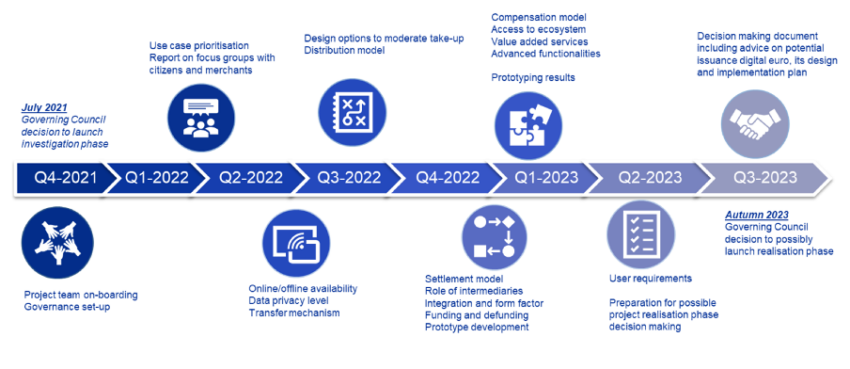Central Bank Digital Currencies (CBDC) implementation continues to see new development in 2023. From Europe to Russia, all have taken significant steps to fasten the process. But at what costs?
Over ninety percent of central banks worldwide are working on Central Bank Digital Currencies or CDBCs. Regions have focused on steady development, from Africa to China, for smooth CBDC deployment.
Europe, in particular, has been rushing to roll out its digital euro. Its second and most recent progress report, titled “Progress on the investigation phase of a digital Euro,” was published towards the end of last year. The European Central Bank (ECB) shared an accelerated timeline vis-à-vis its Sept. 2022 report.

The 2023 Update: Digital Euro CBDC
ECB has been actively exploring a digital euro since October 2021. This was shortly before the crypto market peaked, which is not coincidental. The ECB has explicitly stated that it sees stablecoins as competition. The ECB has actively discussed developing its digital euro with public and private entities.
This digital euro scheme is stated to start to be drafted at present, that is, in Jan. 2023. The European Commission intends to propose a regulation establishing a digital euro in the second quarter of 2023. Even has begun legislative preparations. This means that the digital euro could become live in the next few years.
Further, the report shares a few possible designs for the digital euro. Refraining from resorting to peer-to-peer transactions, the ECB wants most digital euro transactions to involve an intermediary, mainly the big banks. However, the ECB will ultimately control the issuance and settlement of the digital euro. Further, asserting that the intermediaries will act as user-facing side apps, websites, or wallets.
While privacy remains a top priority for many users regarding CDBCs, the ECB has claimed that complete anonymity is impossible with the digital euro. Not just because of crime. But if the digital euro is anonymous, people could protect their purchasing power by holding lots of CDBC. This is something the ECB doesn’t want for financial stability reasons.
For everyday use, the digital euro scheme requires every merchant in the Eurozone to not only accept payments in digital euros. But also can pay employees in digital euros. It also requires that digital euros be made accessible to people without access to digital payments.
CBDC Update in Russia
Across the border, Russia is exploring two possible cross-border CBDC settlement models this quarter. This was in response to the sanctions placed on it due to the ongoing war with Ukraine. The Bank of Russia shared a presentation with Kommersant, a local media outlet. Essential insights were shared with BeInCrypto over Telegram.

Herein, the proposal presents two models that can be taken as a basic version. However, skeptics believe that the technological capabilities and the geopolitical situation will likely keep these models a concept of a distant future.
The initiative is a part of the broader digital ruble project. It aims to build a digital currency that will coexist with cash and non-cash rubles. Unlike virtual currencies such as bitcoin, the digital ruble is projected to pose a minimal risk. Mainly as it will be issued by the state monetary regulator and backed by traditional money.
Two Routes to Look Into
The report shows that the two cross-border CBDC models differ in operation and currency transfer modes. The first model relies on one-on-one bilateral agreements between countries on integrating digital currency platforms among themselves. This would require individual country platforms to facilitate the conversion and transfer of formats between countries according to agreed rules and standards.
The second option adopts a more centralized approach. Herein, each county’s individual platform will be connected to a single integration platform. This will act as a facilitator of payments between digital currency platforms based on unified protocols and standards developed. The integrated platform will serve as a hub, and a star will connect the individual platforms.

The first model presents a more straightforward solution. Whereas the second model ensures transparency since all countries would be connected to a central entity. Roman Prokhorov, Chairman of the Board of the Association of Financial Innovations (AFI), acknowledges,
“The implementation of cross-border settlements using the Central Exhibition Center will depend on the readiness, not so much of the Russian side. Here our jurisdiction to promote the CECB project is confidently in second place after China but on the readiness of our partners”
Practically, the two-way settlement scheme would be implemented initially, beginning with China, considering the technological and political readiness. The multi-party approach seems a futuristic concept, considering global scrutiny over Russia’s invasion of Ukraine. But apart from the geographical tension, CBDCs, in general, do pose some risks.
Concerns to Consider
BeInCrypto extensively covered problems regarding CBDCs, which can be weaponized as a total state surveillance and control tool. Different policy analysts have said otherwise, despite attempts to incorporate privacy in the CBDC. Last year in a Nov. 28 report, Nick Anthony asserted that:
“A CBDC would most likely be the single largest assault on financial privacy since the creation of the Bank Secrecy Act and the establishment of the third-party doctrine.”
Nevertheless, authorities continue to take steps to implement CBDC control whatsoever. Now, 2023 can be a crucial era to understand the practical implementations of CBDCs.
Disclaimer
Following the Trust Project guidelines, this feature article presents opinions and perspectives from industry experts or individuals. BeInCrypto is dedicated to transparent reporting, but the views expressed in this article do not necessarily reflect those of BeInCrypto or its staff. Readers should verify information independently and consult with a professional before making decisions based on this content. Please note that our Terms and Conditions, Privacy Policy, and Disclaimers have been updated.


